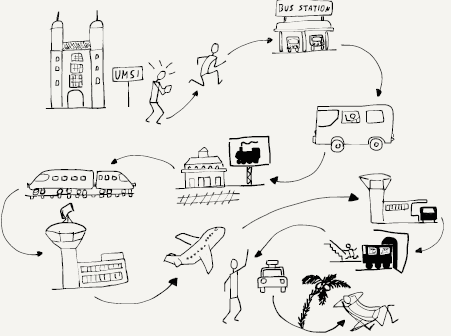Once your packet destined for the Internet makes it across the first link, it will be in a router. Your packet has a source address and destination address and the router needs to look at the destination address to figure out how to best move your packet towards its destination. With each router handling packets destined for any of many billions of destination computers, it’s not possible for every router to know the exact location and best route to every possible destination computer. So the router makes its best guess as to how to get your packet closer to its destination.
Each of the other routers along the way also does its best to get your packet closer to the destination computer. As your packet gets closer to its final destination, the routers have a better idea of exactly where your packet needs to go. When the packet reaches the last link in its journey, the link layer knows exactly where to send your packet.
We use a similar approach to route ourselves when going on holiday. A holiday trip also has many hops. Perhaps the first hop is driving your car or taking a cab or bus to a train station. Then you take a local train from your small town to a larger city. In the larger city you take a long-distance train to a large city in another country. Then you take another local train to the small village where you will stay for your holiday. When you get off the train, you take a bus, and when you get off the bus, you walk to your hotel.
If you were on the train between the two large cities and you asked the conductor the exact location of your hotel in the small village, the conductor would not know. The conductor only knows how to get you closer to your destination, and while you are on the long-distance train that is all that matters. When you get on the bus at your destination village, you can ask the bus driver which stop is closest to your hotel. And when you get off the bus at the right bus stop, you can probably ask a person on the street where to find the hotel and get an exact answer.
The further you are from your destination, the less you need to know the exact details of how to get there. When you are far away, all you need to know is how to get “closer” to your destination. Routers on the Internet work the same way. Only the routers that are closest to the destination computer know the exact path to that computer. All of the routers in the middle of the journey work to get your message closer to its destination.
But just like when you are traveling, unexpected problems or delays can come up that require a change in plans as your packets are sent across the network.

Routers exchange special messages to inform each other about any kind of traffic delay or network outage so that packets can be switched from a route that is no longer working to a different route. The routers that make up the core of the Internet are smart and adapt quickly to both small and large outages or failures of network connections. Sometimes a connection slows down because it is overloaded. Other times a connection is physically broken when a construction crew mistakenly digs up a buried wire and cuts it. Sometimes there is a natural disaster like a hurricane or typhoon that shuts down the routers and links in a large geographical area. The routers quickly detect these outages and reroute around them if possible.
But sometimes things go wrong and packets are lost. Dealing with lost packets is the reason for the next layer in our architecture.